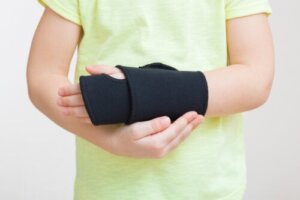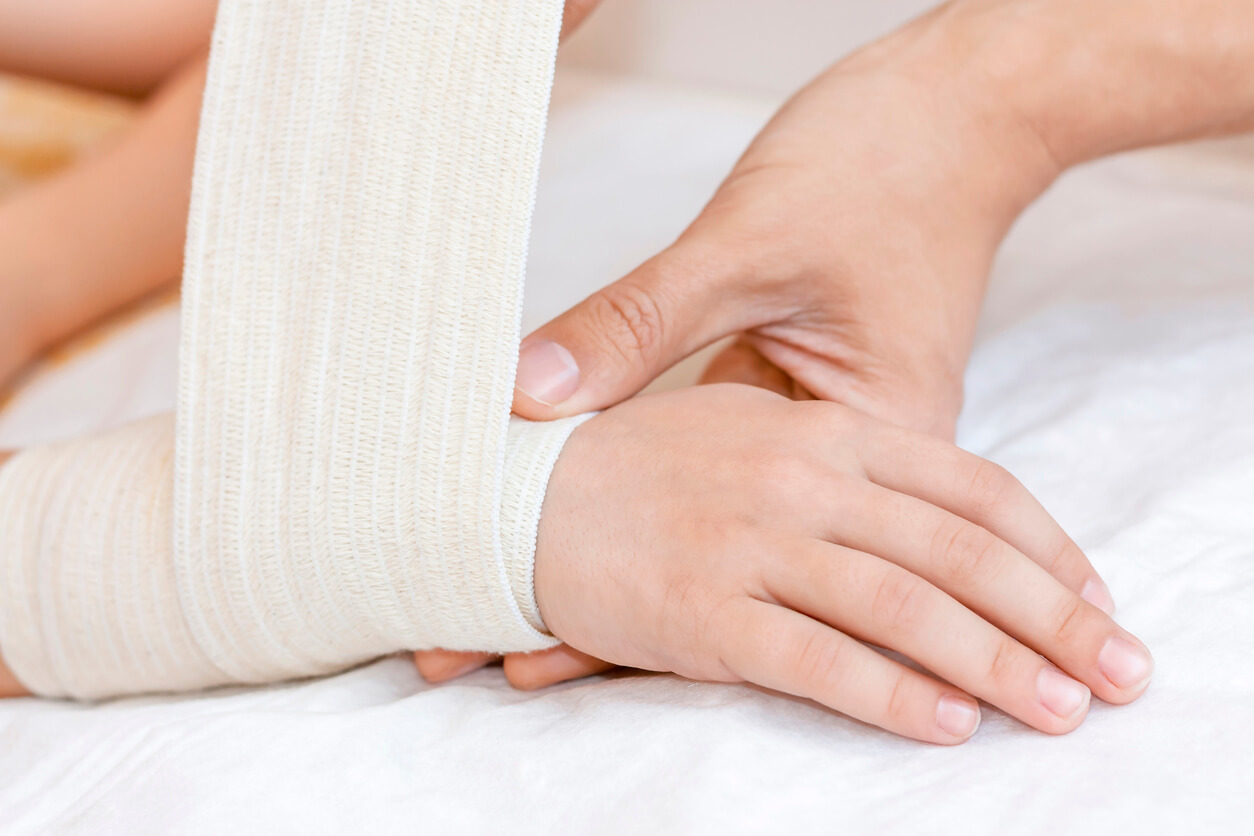How to Care for a Sprained Wrist in Children


Written and verified by the physiotherapist Maria Elisa Lisotti Luppi
Childhood is a very physically active stage of life, during which children are often bruised or injured. Their bodies are very flexible, which allows them to adapt quickly to movements. However, this also favors less stability in the joints, meaning that a simple sprain can lead to a strain. Here, we’ll tell you how to take care of a sprained wrist in children and help reduce the pain.
Physical activity is one of the most necessary healthy habits to encourage in our children. Sports at an early age should be performed with all safety measures to prevent future injuries, as well as games and hobbies. This is an age in which children have little notion of danger, so they don’t consciously measure their actions. This can lead to falls or trauma that can result in further injury.
What is a sprained wrist?
The wrist is a set of small joints that connect the forearm to the hand. In this way, it allows flexibility and mobility. Therefore, it facilitates a great variety of gross and fine gestures in conjunction with the rest of the arm. On the one hand, it has the ends of two long bones of the forearm, the ulna, and the radius. On the other, the articular faces of 4 of the 8 small bones are called carpal bones.
A wrist sprain is an injury that occurs due to excessive lengthening or rupture of the ligaments that support the wrist and causes pain. Ligaments are strong bands of tissue that bind and support the bones together.

Causes and symptoms
A wrist sprain can be caused by direct trauma to the area. Repetitive movements in a certain gesture can also cause such a strain. However, the most frequent cause is a direct fall on the hand, with the arm extended.
In the case of more serious sprains, the picture is accompanied by heat, redness, and sometimes hematoma around the wrist. In the presence of any of these, a doctor should be consulted to rule out possible fractures, tears, or other conditions.
Learn how to care for a child with a sprained wrist
As soon as the trauma occurs or injury is suspected, a pediatrician should be consulted immediately. They’ll request the necessary complementary studies because, as we’ve already said, the symptoms of the sprain can also indicate other diseases.
Once diagnosed, the doctor will indicate the treatment to follow. In mild to moderate cases, it may include immobilizing the joint, together with anti-inflammatory drugs. Also, physical therapy sessions are important to improve symptoms and reduce further complications.
In more severe cases of sprain, surgery is considered to repair the injured ligament. After surgery, physiotherapy treatment is performed to restore strength and stability to the wrist. That is, to restore full functionality. On the other hand, if it’s a mild to moderate sprain, there’s some care that can be performed at home to reduce pain and other symptoms:
- Accompany your child in resting: Staying still is the most difficult task for children in these situations. However, the joint needs to rest to facilitate the natural recovery processes. Therefore, it’s important to guide the child not to use the affected wrist in activities of daily living.
- Apply cold: This should be done for 10 to 15 minutes to the wrist area. Cold helps to reduce inflammation and pain. It can be applied in solid form or cold compresses. Don’t place the cold in direct contact with the skin, but use an enveloping cloth. During the first 2 days, the frequency of application should be every 3 hours. In the following days, it decreases to 4 times a day.
- Elevate the arm: The arm should be held high on the affected side, above the level of the shoulder. This position favors the drainage of the fluid accumulated in the inflamed area, especially in the first hours of the injury, when the congestion is greater.

How to prevent wrist sprains
Bones during childhood contain more water and fewer minerals than those of an adult. Therefore, a healthy diet is the first factor to take into account to prevent pain and wrist sprains in children. In addition, if your child is involved in sports activities, the use of wrist wraps helps to protect the area from trauma.
For sports activities that involve direct impacts on the hands or wrists, it’s important to wear a protective bandage before starting exercise. It’s also essential to warm up well before doing any sport. A neuromuscular elastic bandage is a tool that favors proprioception, thus providing a sensation of greater joint stability.
Finally, it’s important to remember that in the presence of any of the above symptoms, the appropriate medical consultation should be made. In addition, medication shouldn’t be administered to the child without the corresponding professional indication. With an accurate diagnosis and the pediatrician’s recommendations, these tips on how to care for a sprained wrist in children will be of great help.
Childhood is a very physically active stage of life, during which children are often bruised or injured. Their bodies are very flexible, which allows them to adapt quickly to movements. However, this also favors less stability in the joints, meaning that a simple sprain can lead to a strain. Here, we’ll tell you how to take care of a sprained wrist in children and help reduce the pain.
Physical activity is one of the most necessary healthy habits to encourage in our children. Sports at an early age should be performed with all safety measures to prevent future injuries, as well as games and hobbies. This is an age in which children have little notion of danger, so they don’t consciously measure their actions. This can lead to falls or trauma that can result in further injury.
What is a sprained wrist?
The wrist is a set of small joints that connect the forearm to the hand. In this way, it allows flexibility and mobility. Therefore, it facilitates a great variety of gross and fine gestures in conjunction with the rest of the arm. On the one hand, it has the ends of two long bones of the forearm, the ulna, and the radius. On the other, the articular faces of 4 of the 8 small bones are called carpal bones.
A wrist sprain is an injury that occurs due to excessive lengthening or rupture of the ligaments that support the wrist and causes pain. Ligaments are strong bands of tissue that bind and support the bones together.

Causes and symptoms
A wrist sprain can be caused by direct trauma to the area. Repetitive movements in a certain gesture can also cause such a strain. However, the most frequent cause is a direct fall on the hand, with the arm extended.
In the case of more serious sprains, the picture is accompanied by heat, redness, and sometimes hematoma around the wrist. In the presence of any of these, a doctor should be consulted to rule out possible fractures, tears, or other conditions.
Learn how to care for a child with a sprained wrist
As soon as the trauma occurs or injury is suspected, a pediatrician should be consulted immediately. They’ll request the necessary complementary studies because, as we’ve already said, the symptoms of the sprain can also indicate other diseases.
Once diagnosed, the doctor will indicate the treatment to follow. In mild to moderate cases, it may include immobilizing the joint, together with anti-inflammatory drugs. Also, physical therapy sessions are important to improve symptoms and reduce further complications.
In more severe cases of sprain, surgery is considered to repair the injured ligament. After surgery, physiotherapy treatment is performed to restore strength and stability to the wrist. That is, to restore full functionality. On the other hand, if it’s a mild to moderate sprain, there’s some care that can be performed at home to reduce pain and other symptoms:
- Accompany your child in resting: Staying still is the most difficult task for children in these situations. However, the joint needs to rest to facilitate the natural recovery processes. Therefore, it’s important to guide the child not to use the affected wrist in activities of daily living.
- Apply cold: This should be done for 10 to 15 minutes to the wrist area. Cold helps to reduce inflammation and pain. It can be applied in solid form or cold compresses. Don’t place the cold in direct contact with the skin, but use an enveloping cloth. During the first 2 days, the frequency of application should be every 3 hours. In the following days, it decreases to 4 times a day.
- Elevate the arm: The arm should be held high on the affected side, above the level of the shoulder. This position favors the drainage of the fluid accumulated in the inflamed area, especially in the first hours of the injury, when the congestion is greater.

How to prevent wrist sprains
Bones during childhood contain more water and fewer minerals than those of an adult. Therefore, a healthy diet is the first factor to take into account to prevent pain and wrist sprains in children. In addition, if your child is involved in sports activities, the use of wrist wraps helps to protect the area from trauma.
For sports activities that involve direct impacts on the hands or wrists, it’s important to wear a protective bandage before starting exercise. It’s also essential to warm up well before doing any sport. A neuromuscular elastic bandage is a tool that favors proprioception, thus providing a sensation of greater joint stability.
Finally, it’s important to remember that in the presence of any of the above symptoms, the appropriate medical consultation should be made. In addition, medication shouldn’t be administered to the child without the corresponding professional indication. With an accurate diagnosis and the pediatrician’s recommendations, these tips on how to care for a sprained wrist in children will be of great help.
All cited sources were thoroughly reviewed by our team to ensure their quality, reliability, currency, and validity. The bibliography of this article was considered reliable and of academic or scientific accuracy.
- Til, Luis, and Rossend Ullot. “9. Lesiones deportivas en niños y adolescentes.” La actividad física mejora el aprendizaje y el rendimiento escolar: 123.
- Olmedo, J. López. “Fracturas infantiles más frecuentes. Esguinces y epifisiolisis.” PediatríaIntegral 221 (2019): 222
- Salvatierra Pincay, Olga Asunción. Los primeros auxilios en la atención de los accidentes escolares en niños y niñas de educación inicial II en la escuela Clementina Triviño de Unda de la zona 8 del distrito 09d05 de la parroquia Tarqui del cantón Guayaquil provincia del Guayas periodo lectivo 2017-2018. BS thesis. Universidad de Guayaquil Facultad de Filosofía, Letras y Ciencias de la Educación, 2017.
- Zárate Montero, Haydee Elizabeth. “Tratamiento fisioterapéutico en esguince crónico de tobillo.” (2017).
- Cobos Cevallos, Cristhian Patricio, and Jennifer Carolina Guayta Torres. Implementación de un sistema háptico para rehabilitación activa de muñeca en el consultorio “Huellas fisioterapia”. BS thesis. Quito, 2020., 2020.
- Fernández, Leticia Boyero. “PATOLOGÍA DE MANO Y MUÑECA.” DE CONSULTA RÁPIDA (2019): 666.
This text is provided for informational purposes only and does not replace consultation with a professional. If in doubt, consult your specialist.








